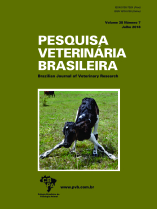 |
|
|
|
Year 2018 - Volume 38, Number 7
|

|
Prevalence of antibodies and risk factors associated with infection by Toxoplasma gondii in free range chickens of rural area of Santa Maria, Rio Grande do Sul, Brazil, 38(7):1351-1357
|
ABSTRACT.- Camillo G., Machado M.E.A., Weber A., Cadore G.C., Menezes F.R., Pardini L., Sangioni L.A. & Vogel F.S.F. 2018. [Prevalence of antibodies and risk factors associated with infection by Toxoplasma gondii in free range chickens of rural area of Santa Maria, Rio Grande do Sul, Brazil.] Prevalência de anticorpos e fatores de risco associados à infecção por Toxoplasma gondii em galinhas domésticas de zona rural de Santa Maria, Rio Grande do Sul. Pesquisa Veterinária Brasileira 38(7):1351-1357. Laboratório de Doenças Parasitárias, Universidade Federal de Santa Maria, Av. Roraima 1000, Santa Maria, RS 97105-900, Brazil. E-mail: giovanacamillo@yahoo.com.br
Toxoplasma gondii is an apicomplex protozoan that infects warm-blooded animals and can be considered a major parasite capable of infecting humans. Domestic chickens can be easily infected by protozoa, since they can ingest oocysts found in the soil and are considered good indicators of environmental contamination by T. gondii. The aim of this study was to determine the presence of anti-T. gondii antibodies in free range chickens and to evaluate the risks factors associated with the protozoan in rural area of Santa Maria, RS, Brazil. From March 2013 to February 2014, 597 blood samples from domestic chickens were collected from 74 farms, from nine layers representing each district in the rural area. To evaluate the risk factors, in these farms an epidemiological questionnaire was applied to the residents. Serum samples were tested by indirect immunofluorescence and 49.2% (294/597) were positive for anti-T.gondii antibodies, with titres varying from 16 to 4096. Of the 74 analyzed farms, 63 (85.1%) reported that cats had access to food deposits, with a significant association when positive chickens were present (p = 0.04) and the OR of 4.07. The variable “slaughter of animals” (poultry and cattle) in 51 (68.9%) of the farms was reported the slaughter of cattle and birds in the farm, with significant p value (p = 0.05). Most farms 59 (79.7%) reported the presence of domestic cats, which could be associated with the high seroprevalence found in chickens and the rate of environmental contamination. The high prevalence of antibodies found in this study, in addition to the high frequency of farms with positive cases, suggests a great environmental contamination in the studied districts, thus being a potential risk to human and animal health. |
| |
|
|
| |
|
 |